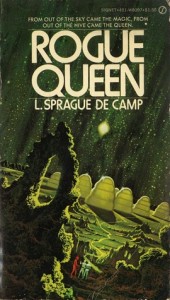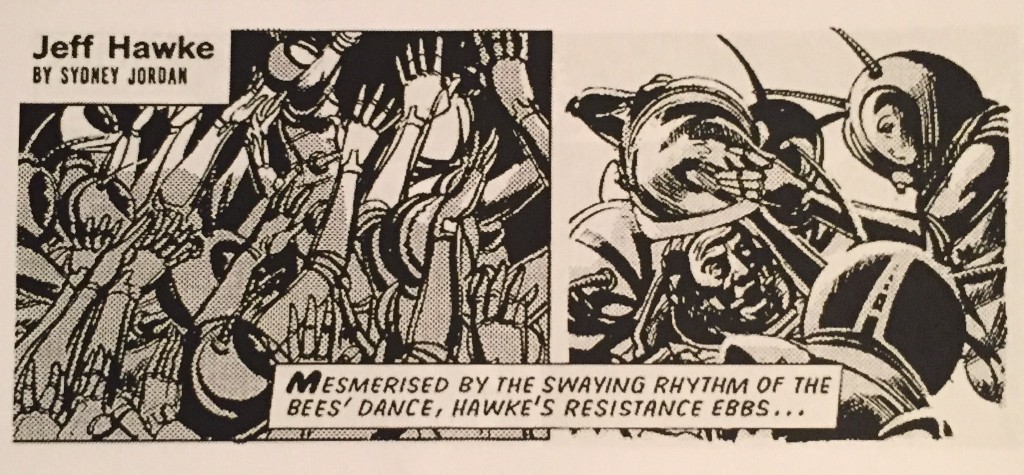![]() The BEES ON DAEDALUS is unusual in the Hawke canon for its almost mythic quality, somewhat analogous to the medieval romance where the hero rescues the besieged queen, marries her and frees her people – although in Hawke’s case as an unwitting protagonist. Hawke is stranded on an Asteroid that is honeycombed with inumerable cells and populated by a race of creatures, who , although humanoid , live as a population of insects , in a colony where the individual is of no account and where consciousness only manifests itself as a collective entity. The colony comprises female workers and a queen who alone is capable of independent thought. The colony can be regarded as one entity and the workers seen as mere extentions of the queen’s will.Hers is the guiding consciousness of the entire hive. Presumably there are also drones elsewhere, but we do not meet them.
The BEES ON DAEDALUS is unusual in the Hawke canon for its almost mythic quality, somewhat analogous to the medieval romance where the hero rescues the besieged queen, marries her and frees her people – although in Hawke’s case as an unwitting protagonist. Hawke is stranded on an Asteroid that is honeycombed with inumerable cells and populated by a race of creatures, who , although humanoid , live as a population of insects , in a colony where the individual is of no account and where consciousness only manifests itself as a collective entity. The colony comprises female workers and a queen who alone is capable of independent thought. The colony can be regarded as one entity and the workers seen as mere extentions of the queen’s will.Hers is the guiding consciousness of the entire hive. Presumably there are also drones elsewhere, but we do not meet them. 
The idea of the hive-mind has been used by many sci-fi writers since HG Wells first penned EMPIRE OF THE ANTS, a short story published in 1905, in which a Portugeuse captain is sent on a mission up the Amazon river to investigate the ravages of an ant colony which has acquired a collective intelligence and which is destroying human settlements along the river. The portrayal of the hive mind has almost always been seen as an abhorrent thing, opposed to the basic values of Human individuality, and its guiding consciousness as an evil to be removed. An interesting work in this regard is Frank Herbert’s HELLSTROM’S HIVE (1973), a truly horrifying study, in which the hive society is compared to the human and in which the hive has its own very disturbing moralities but which make a chilling sense in their own terms. Closer to Sydney’s story is Sprague de Camp’s ROGUE QUEEN (1952) in which an expedition from Earth lands on the planet Ormazd where the dominant humanoid species live in hive societies under the iron control of a fertile queen. The main population, as in THE BEES ON DAEDALUS comprise infertile females and a group of drones who service the queen. Its main protagonist is one such female called Iroedh who is pursued by the hive after trying to free one of the hive drones who has been sentenced to death . Forced in her exile to eat meat , which the hive teaches is poison to all females except the queen, she discovers instead that not only does it do her no harm , but brings about her own sexual maturity. She thus becomes a rival to the hive queen, and the dissemination of this knowledge , which allows drones and females to be paired , causes the collapse of the hive system.

Sexual relations are also the catalyst for change in BEES ON DAEDELUS , but in this case it is the introduction of Hawke’s DNA into the mix which will eventually free the “bees” by giving their descendents the ability to think and act autonomously. The queen in THE BEES ON DAEDALUS , unlike that in ROGUE QUEEN is portrayed sympathetically, not as a tyrant but rather as a mother trying to free her children from their enslavement by an un-named alien race who has hitherto held them in thrall.
Skipper Prossitt
The full story of THE BEES ON DAEDALUS can be found in JEFF HAWKE COSMOS Vol6 No3, and is available to buy from the JEFF HAWKE CLUB
